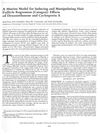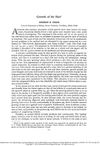A Guide to Assessing Damage Response Pathways of the Hair Follicle: Lessons From Cyclophosphamide-Induced Alopecia in Mice
July 2005
in “Journal of Investigative Dermatology”

TLDR The document concludes that assessing hair follicle damage due to cyclophosphamide in mice involves analyzing structural changes and suggests a scoring system for standardized evaluation.
The 2005 document provides a guide for assessing hair follicle damage in mice, specifically due to cyclophosphamide-induced alopecia. It describes two damage-response pathways: "dystrophic anagen," caused by lower doses of cyclophosphamide, leading to a prolonged anagen phase and delayed recovery, and "dystrophic catagen," caused by higher doses, resulting in immediate anagen termination, a shortened telogen phase, and rapid recovery. The guide offers criteria for classifying hair follicle dystrophy, such as structural changes, pigmentation variations, and the number of apoptotic keratinocytes. It also discusses the importance of evaluating ectopic melanin, the dermal papilla shape, and the hair canal lumen width. The document suggests using a "dystrophy score" for quantitative assessment and emphasizes the need for ultrastructural confirmation when making definitive statements on apoptosis. This guide aims to standardize the assessment of hair follicle damage and can be applied to other hair-bearing animals with species-specific considerations.
View this study on jidonline.org →
Cited in this study
research Overexpression of Bcl-2 Protects from Ultraviolet B-Induced Apoptosis but Promotes Hair Follicle Regression and Chemotherapy-Induced Alopecia

research A Murine Model for Inducing and Manipulating Hair Follicle Regression (Catagen): Effects of Dexamethasone and Cyclosporin A
Dexamethasone speeds up hair loss in mice, while cyclosporin A slows it down.

research Growth of the Hair
Related

research Progenic hair regrowth treatment- The use of platelet-released growth factors for treating androgenetic alopecia (AGA) by activating hair follicle stem cells
Platelet-released growth factors can treat hair loss by activating hair follicle stem cells, blocking certain pathways, and controlling inflammation and fibrosis.